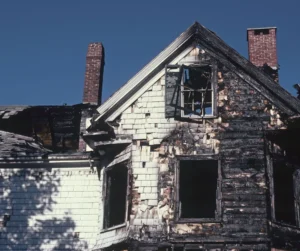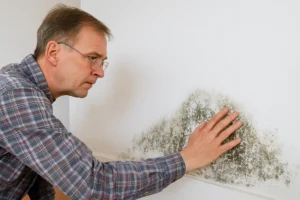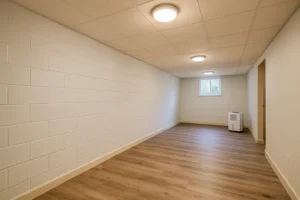You finally did it—you found mold in your home, got a professional mold inspection, and paid for full remediation. The cleanup crew packed up, the smell is gone, the walls look good again… and then, a few weeks or months later, that unmistakable musty odor creeps back in.
You’re not imagining it.
And yes, mold can come back after remediation—but it shouldn’t if the job was done right and the cause was fixed.
In this article, we’ll explain:
- Why mold sometimes returns after remediation
- What proper remediation should include
- How you can prevent mold from coming back
When to call the professionals (again)
Understanding Mold: A Living, Breathing Problem
Mold is a living organism that reproduces through airborne spores. It thrives in moist, dark, and warm environments, especially where organic materials like wood, drywall, or insulation are present.
When a mold colony is growing in your home, it’s not just a surface issue. Mold often spreads behind walls, beneath flooring, inside vents, or around plumbing—anywhere moisture collects.
Even after it’s cleaned up, if those conditions remain, mold can regrow—sometimes in the same spot, sometimes nearby.
The Short Answer: Yes, Mold Can Come Back After Remediation
But there’s a difference between mold regrowth due to a persistent moisture problem and remediation that wasn’t done properly.
Here’s what might lead to mold returning after professional work:
1. Moisture Was Never Fully Eliminated
If the original source of moisture—like a leak, condensation, or high humidity—wasn’t identified and fixed, mold spores will find it again.
2. Incomplete Cleaning
Mold remediation isn’t just spraying something on the wall. If all contaminated materials weren’t removed (like wet insulation, rotted wood, or moldy drywall), hidden spores may survive.
3. Poor Ventilation
Even after remediation, a home that doesn’t have proper air circulation or humidity control is still mold-prone.
4. Cross Contamination
If technicians didn’t use containment methods (like sealing off rooms or using air scrubbers), spores may have spread during the cleanup process, leading to growth in other parts of the home.
5. Delayed Remediation
Waiting too long after water damage gives mold more time to grow and spread. Read more about how fast mold grows after water damage to understand the urgency.
What Proper Mold Remediation Should Include
Professional mold remediation (like what we provide at Tradewinds Restoration) is not just about cleaning visible mold. It should include:
Full Inspection
This includes checking all areas where moisture may collect, including behind walls, under floors, in attics, crawl spaces, or inside HVAC systems.
Source Identification
Safe Containment
The area should be sealed off using plastic sheeting, negative air pressure, and HEPA filters to stop spores from spreading.
Complete Removal of Affected Materials
Cleaning and Disinfection
Clearance Testing (if needed)
This ensures no remaining mold is detectable after remediation.
If your previous provider skipped any of these steps, that might explain why the mold came back.
How to Know If Mold Has Returned
It’s not always visible at first. Here are signs that mold may be back—even after you’ve had it removed:
- A persistent musty or earthy smell
- Stains or discoloration returning on walls, ceilings, or flooring
- Warped drywall or soft spots near where mold was previously removed
- Symptoms like coughing, sneezing, headaches, or fatigue indoors
- New areas developing mold (especially in rooms adjacent to the original site)
How to Keep Mold from Coming Back
Control Humidity
Improve Ventilation
Install exhaust fans in bathrooms and kitchens. Open windows when weather allows.
Fix Leaks Quickly
Clean and Dry Damp Areas
Dry wet floors, carpets, or upholstery right away after spills or leaks.
Don’t Cover It Up
Why Work With Tradewinds Restoration?
At Tradewinds Restoration, we’ve handled thousands of mold remediation jobs across San Diego—and we do it right the first time.
Here’s what sets us apart:
- Detailed inspections with moisture tracking tools
- Transparent pricing: inspections start at $239, full remediation ranges from $1,800–$10,000
- Trained technicians with industry certifications
- Insurance support—we help document and submit claims
- Long-term prevention advice
You don’t have to keep fighting the same mold problem. We’ll help you find it, remove it, and stop it from coming back.
Contact us today to schedule a mold inspection or get a second opinion on a previous remediation.
When to Call Us Back
If you’ve had mold removed but notice signs it might be returning, don’t wait. The sooner we re-inspect the area, the better chance we have of fixing the issue without a full redo.
Common scenarios we see:
- Recurring mold in bathrooms or basements
- Mold returns after roof leak repair
- Past remediation didn’t address attic or HVAC mold
- Homeowners who bought a house with previous mold history
What If Your Mold Problem Was Covered by Insurance?
Good news: in many cases, insurance will cover return visits if it’s related to a covered event—like a pipe burst or storm damage.
Our team can:
- Re-inspect the problem
- Take moisture readings and new photos
- Create a professional report
- Help you submit it to your insurance company
Read more about our process: Mold Remediation Services
Mold Doesn’t Have to Come Back
The question “Can mold come back after remediation?” is a fair one, and the answer depends on how the remediation was handled and what you do next.
When done thoroughly, with the source of moisture fixed and preventative steps taken, mold should not come back.
If you’re dealing with repeat mold problems, don’t give up. Get help from a team that knows how to tackle the entire problem, from inspection to prevention.
Let’s make sure your mold problem is gone for good.
Schedule your inspection with Tradewinds Restoration today.





